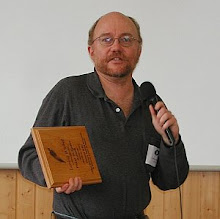 Given the strange conscious states of the fall, amidst PHN attacks and pixelslips and whatnot, it was an odd experience to attend the Defrag conference in Denver in mid-November, dedicated to trying to find larger meaning and structure in the emergent social networks that have taken over most static web sites. I have identified two problem areas in posts on the Smartbook blog, here and here. I'll summarize those areas below, but first a word about the tie between true believers and marketing: Defrag and its cousin Glue are often given kudos for avoiding the marketing hype of conferences like Web 2.0. Nevertheless, Bill Joy of Sun Microsystems warned us long ago, regarding nanotechnology, that even sober engineers and programmers can be drinkers-of-Kool-Aid if they speak of technological promises without probing negative social consequences. Defrag 2009 had a bit of that back-slapping feel. Twitter and real-time streams and Facebook and live-update aggregation were given a heavier dissection than in other venues, true, but there was a little too much self-congratulatory examination of the synaptic web without enough deep critique. Still, here's what I found interesting in what real-time web pundits had to say:
Given the strange conscious states of the fall, amidst PHN attacks and pixelslips and whatnot, it was an odd experience to attend the Defrag conference in Denver in mid-November, dedicated to trying to find larger meaning and structure in the emergent social networks that have taken over most static web sites. I have identified two problem areas in posts on the Smartbook blog, here and here. I'll summarize those areas below, but first a word about the tie between true believers and marketing: Defrag and its cousin Glue are often given kudos for avoiding the marketing hype of conferences like Web 2.0. Nevertheless, Bill Joy of Sun Microsystems warned us long ago, regarding nanotechnology, that even sober engineers and programmers can be drinkers-of-Kool-Aid if they speak of technological promises without probing negative social consequences. Defrag 2009 had a bit of that back-slapping feel. Twitter and real-time streams and Facebook and live-update aggregation were given a heavier dissection than in other venues, true, but there was a little too much self-congratulatory examination of the synaptic web without enough deep critique. Still, here's what I found interesting in what real-time web pundits had to say:First, the notion of searching static web sites is becoming as archaic as an encyclopedia on a CD-ROM. Information arises in an emergent fashion through the sharing and discovery of information real-time across social media sites. This means that the interface of choice moves away from a Word or Excel document, or even an email inbox, and toward a real-time status update feed. What we see at the top of a Facebook page of Tweetdeck may be the interface of choice for many information sites in the future. How does any data-management system keep up with this torrential real-time feed and filter out relevant information without missing key nuggets? Good question.
In the second part of my Smartbook posts, I addressed a tougher topic that arose with Khris Loux's presentation on the synaptic web. If we really want to consider client nodes (human individuals, usually) in social networks to be the equivalent of a synapse, then all those rules about neural-network behavior - learning through back-propagation, finding a higher state of consciousness through simulated annealing, etc. - apply. There is also the issue of allowing the uber-brain of a global network to establish long-term memory through the different oscillatory pattern of a sleep cycle. Where does that exist in the constant chattery updates of Twitter or Facebook? The notion of an institutional memory gets shallower and shallower. Keynote speaker Stowe Boyd pointed out that Twitter "memory" now has decreased from two weeks to two days, and may be shrunk to minutes if Twitter's growth trend continues. A conscious, sentient entity without a working memory is reduced to sound and fury, signifying nothing.
Some people in the journalism community fret about how the replacement of real newsgathering by quick tweets will significantly harm people's understanding of the world around them. Others who study consciousness itself are concerned that social networks, particularly rapid-update systems like Twitter, will encourage superficiality more than the rapid channel-changing that was the source of so much hand-wringing in the 1980s. But that merely mentions two manifestations of a larger issue: The synaptic web that is emerging based on shared communities using real-time feeds, is a creature living in the present and lumbering forward of its own accord. On a certain level, we have lopped off large sections of the cortex and cerebellum in this global brain, and have reduced the global consciousness to its limbic level. The synaptic web needs to re-evolve a higher brain function, which can accommodate memory and analysis even as real-time streams grow exponentially. Short of a global crisis of some sort, we are not going to be stopping those constant tweetstorms and live-update feeds. We need to find a way to recapture remembering, to design an institutional memory, even in the midst of a synaptic storm.








No comments:
Post a Comment